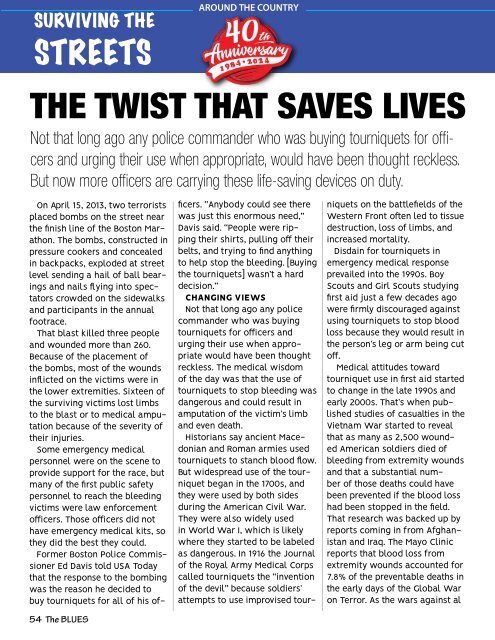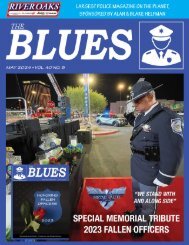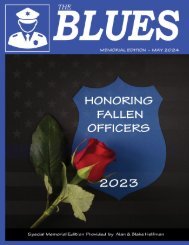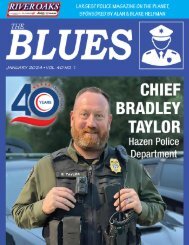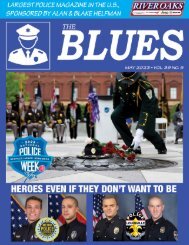Nov 2023. Blues Vol 39 No. 11
FEATURES 62 Alan Helfman: 40 Years of Support and Friendship 78 Working for Harris County SO in 1984 80 Is a New Home in Your Future PUBLISHER’S THOUGHTS EDITOR REX EVANS THOUGHTS COMING NEXT MONTH GUEST COMMENTARY - DOUG GRIFFITH GUEST COMMENTARY - DANIEL CARR NEWS AROUND THE US SURVIVING THE STREETS - TOURNIQUETS SURVIVING THE STREETS - BYRNA LE ISD PD JOB LISTINGS CALENDAR OF EVENTS REMEMBERING OUR FALLEN HEROES WAR STORIES AFTERMATH HEALING OUR HEROES DARYL’S DELIBERATIONS BLUE MENTAL HEALTH DR. LIGHT BULB AWARD ADS BACK IN THE DAY PARTING SHOTS BUYERS GUIDE NOW HIRING BACK PAGE
FEATURES
62 Alan Helfman: 40 Years of Support and Friendship
78 Working for Harris County SO in 1984
80 Is a New Home in Your Future
PUBLISHER’S THOUGHTS
EDITOR REX EVANS THOUGHTS
COMING NEXT MONTH
GUEST COMMENTARY - DOUG GRIFFITH
GUEST COMMENTARY - DANIEL CARR
NEWS AROUND THE US
SURVIVING THE STREETS - TOURNIQUETS
SURVIVING THE STREETS - BYRNA LE
ISD PD JOB LISTINGS
CALENDAR OF EVENTS
REMEMBERING OUR FALLEN HEROES
WAR STORIES
AFTERMATH
HEALING OUR HEROES
DARYL’S DELIBERATIONS
BLUE MENTAL HEALTH DR.
LIGHT BULB AWARD
ADS BACK IN THE DAY
PARTING SHOTS
BUYERS GUIDE
NOW HIRING
BACK PAGE
You also want an ePaper? Increase the reach of your titles
YUMPU automatically turns print PDFs into web optimized ePapers that Google loves.
SURVIVING THE<br />
STREETS<br />
AROUND THE COUNTRY<br />
THE TWIST THAT SAVES LIVES<br />
<strong>No</strong>t that long ago any police commander who was buying tourniquets for officers<br />
and urging their use when appropriate, would have been thought reckless.<br />
But now more officers are carrying these life-saving devices on duty.<br />
54 The BLUES<br />
On April 15, 2013, two terrorists<br />
placed bombs on the street near<br />
the finish line of the Boston Marathon.<br />
The bombs, constructed in<br />
pressure cookers and concealed<br />
in backpacks, exploded at street<br />
level sending a hail of ball bearings<br />
and nails flying into spectators<br />
crowded on the sidewalks<br />
and participants in the annual<br />
footrace.<br />
That blast killed three people<br />
and wounded more than 260.<br />
Because of the placement of<br />
the bombs, most of the wounds<br />
inflicted on the victims were in<br />
the lower extremities. Sixteen of<br />
the surviving victims lost limbs<br />
to the blast or to medical amputation<br />
because of the severity of<br />
their injuries.<br />
Some emergency medical<br />
personnel were on the scene to<br />
provide support for the race, but<br />
many of the first public safety<br />
personnel to reach the bleeding<br />
victims were law enforcement<br />
officers. Those officers did not<br />
have emergency medical kits, so<br />
they did the best they could.<br />
Former Boston Police Commissioner<br />
Ed Davis told USA Today<br />
that the response to the bombing<br />
was the reason he decided to<br />
buy tourniquets for all of his officers.<br />
“Anybody could see there<br />
was just this enormous need,”<br />
Davis said. “People were ripping<br />
their shirts, pulling off their<br />
belts, and trying to find anything<br />
to help stop the bleeding. [Buying<br />
the tourniquets] wasn’t a hard<br />
decision.”<br />
CHANGING VIEWS<br />
<strong>No</strong>t that long ago any police<br />
commander who was buying<br />
tourniquets for officers and<br />
urging their use when appropriate<br />
would have been thought<br />
reckless. The medical wisdom<br />
of the day was that the use of<br />
tourniquets to stop bleeding was<br />
dangerous and could result in<br />
amputation of the victim’s limb<br />
and even death.<br />
Historians say ancient Macedonian<br />
and Roman armies used<br />
tourniquets to stanch blood flow.<br />
But widespread use of the tourniquet<br />
began in the 1700s, and<br />
they were used by both sides<br />
during the American Civil War.<br />
They were also widely used<br />
in World War I, which is likely<br />
where they started to be labeled<br />
as dangerous. In 1916 the Journal<br />
of the Royal Army Medical Corps<br />
called tourniquets the “invention<br />
of the devil” because soldiers’<br />
attempts to use improvised tourniquets<br />
on the battlefields of the<br />
Western Front often led to tissue<br />
destruction, loss of limbs, and<br />
increased mortality.<br />
Disdain for tourniquets in<br />
emergency medical response<br />
prevailed into the 1990s. Boy<br />
Scouts and Girl Scouts studying<br />
first aid just a few decades ago<br />
were firmly discouraged against<br />
using tourniquets to stop blood<br />
loss because they would result in<br />
the person’s leg or arm being cut<br />
off.<br />
Medical attitudes toward<br />
tourniquet use in first aid started<br />
to change in the late 1990s and<br />
early 2000s. That’s when published<br />
studies of casualties in the<br />
Vietnam War started to reveal<br />
that as many as 2,500 wounded<br />
American soldiers died of<br />
bleeding from extremity wounds<br />
and that a substantial number<br />
of those deaths could have<br />
been prevented if the blood loss<br />
had been stopped in the field.<br />
That research was backed up by<br />
reports coming in from Afghanistan<br />
and Iraq. The Mayo Clinic<br />
reports that blood loss from<br />
extremity wounds accounted for<br />
7.8% of the preventable deaths in<br />
the early days of the Global War<br />
on Terror. As the wars against al


